

| Visitors Now: | |
| Total Visits: | |
| Total Stories: |

| Story Views | |
| Now: | |
| Last Hour: | |
| Last 24 Hours: | |
| Total: | |
Astronomers Detect Vast Amounts Of Gas And Dust Around Black Hole In Early Universe
This image shows the bright emission from carbon and dust in a galaxy surrounding the most distant supermassive black hole known. At a distance corresponding to 740 Million years after the Big Bang, the Carbon line, which is emitted by the galaxy at infrared wavelengths (that are unobservable from the ground), is redshifted, because of the expansion of the Universe, to millimeter wavelengths where it can be observed using facilities such as the IRAM Plateau de Bure Interferometer.

The Institut de Radioastronomie Millimetrique (IRAM) array is made up of six 15-m size telescopes that detect emission at millimetre wavelengths (about ten thousand times as long as visible light) sited on the 2550-m high Plateau de Bure in the French Alps. The IRAM telescopes work together to simulate a single much larger telescope in a so-called interferometer that can study objects in fine detail.
A recent upgrade to IRAM allowed the scientists to detect the newly discovered gas and dust that includes significant quantities of carbon. This is quite unexpected, as the chemical element carbon is created via nuclear fusion of helium in the centres of massive stars and ejected into the galaxy when these stars end their lives in dramatic supernova explosions.
Dr Venemans comments: "It’s really puzzling that such an enormous amount of carbon-enriched gas could have formed at these early times in the universe. The presence of so much carbon confirms that massive star formation must have occurred in the short period between the Big Bang and the time we are now observing the galaxy.”
This image of J1120+0641 (red dot in the center) was created by combining survey data in visual and infrared light of the Sloan Digital Sky Survey and the UKIRT Infrared Deep Sky Survey.

Credit: ESO/UKIDSS/SDSS
From the emission from the dust, Venemans and his team are able to show that the galaxy is still forming stars at a rate that is 100 times higher than in our Milky Way.
They give credit to the IRAM upgrade that made the new discovery possible. "Indeed, we would not have been able to detect this emission only a couple years ago." says team member Dr Pierre Cox, director of IRAM.
The astronomers are excited about the fact that this source is also visible from the southern hemisphere where the Atacama Large Millimeter/submillimeter Array (ALMA), which will be the world's most advanced sub-millimetre / millimetre telescope array, is currently under construction in Chile. Observations with ALMA will enable a detailed study of the structure of this galaxy, including the way the gas and dust moves within it.
Dr Richard McMahon, a member of the team from the University of Cambridge in the UK is looking forward to when ALMA is fully operational later this year. “The current observations only provide a glimpse of what ALMA will be capable of when we use it to study the formation of the first generation of galaxies."
Contacts and sources:
Dr Robert Massey
Royal Astronomical Society
The related research paper can be found at http://arxiv.org/abs/1203.5844
Read more at Nano Patents and Innovations
Source:


